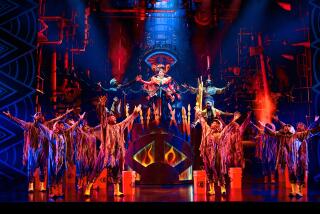From the Archives: Even decades later, the music, choreography and effect of ‘West Side Story’ are hard to resist
- Share via
EDITOR’S NOTE: On Oct. 18, 1961, “West Side Story” hit movie theaters. To commemorate the anniversary of that event, here is the original Los Angeles Times review of the film.
“West Side Story” will be the American picture to watch at Oscar time, for it restores something of the glory that was Hollywood — and Academy voters are a chauvinistic bunch. And glory is the word, even though all of the story takes place amid the bricks and pavements of a New York slum — shot partly “on-location,” but mostly in a slum city virtually re-created at Goldwyn studio by Boris Leven.
In a Sunday Calendar preview Oct. 29 of “West Side Story” I observed that its effect was like being hit by a ton of those same bricks. Its impact as a stage play was as disturbing as it was shattering, and now everything has been magnified countless times in Panavision 70 and Technicolor on the spreading screen at the Chinese Theater, where the production had its benefit premiere Wednesday night.
Is the impact correspondingly greater? The first impression one gets is that it is all too self-conscious to be real — as, in an astonishing series of views of its skyline from a helicopter, Daniel Fapp’s camera makes all of Manhattan serve as its opening set before zooming down on the school playground where the Jets and Sharks, the “heroes” of our tale, are just beginning to strut their sinister stuff.
As one who had seen the play, I experienced, again, all my original amazement at the intricacy and artfulness of Jerome Robbins’ gravity-defying choreography — but this was still “theater.” Just where I became personally involved is hard to say, but it was probably during the Dance at the Gym, at which Tony and Maria, the Romeo and Juliet of the tragedy, first meet. Robbins and co-director Robert Wise make this an enchanted and enchanting moment indeed as the pair have eyes only for one another; the other dancers misted out.
I daresay most spectators will also find the pull of this film irresistible. The — hardest — problem faced by its adapters must have been one of intangibles — how to make an essentially ballet-opera form believable as realistic cinema — and they have all but licked it. “West Side Story” never quite shakes off an aura of pretentiousness but its portentousness is stronger and that is all to the good. For this is ominous drama, and its climaxing rumble (led up to in the brilliant counterpoint of “Tonight”), the later council of the panicked Jets in garage (“Cool”) and the final gun-play in the darkened playground are harsh and frightening commentaries on the whole tragedy of juvenile delinquency.
The Leonard Bernstein score is harsh too, though it has its lyrical passages in “Maria,” “I Feel Pretty” and other songs (arias?) as sung, at least ostensibly, by Natalie Wood as Maria, Richard Beymer as Tony, Rita Moreno as Anita and the rest. Both Miss Wood and Miss Moreno are permitted to work up fine fervors in their acting, and they come through. Beymer is too pretty-boy to persuade us that he could have been co-founder of the Jets; his mooning over Maria is more believable.
The faces that linger longest in the memory, however, are the members of the two gangs — mocking, thoughtlessly cruel, almost too alien to be pitiable. Standouts are George Chakiris, saturnine leader of the Puerto Rican Sharks; Russ Tamblyn, Jets’ chief; Tucker Smith as Ice, Tony Mordente (Action) and Jose De Vega (Chino). Their “Gee, Officer Krupke!” while murderously funny, will make your blood run cold; their “Cool,” even colder.
The few adults around include Simon Oakland and William Bramley, coppers, and Ned Glass as Doc.
More to Read
Only good movies
Get the Indie Focus newsletter, Mark Olsen's weekly guide to the world of cinema.
You may occasionally receive promotional content from the Los Angeles Times.










